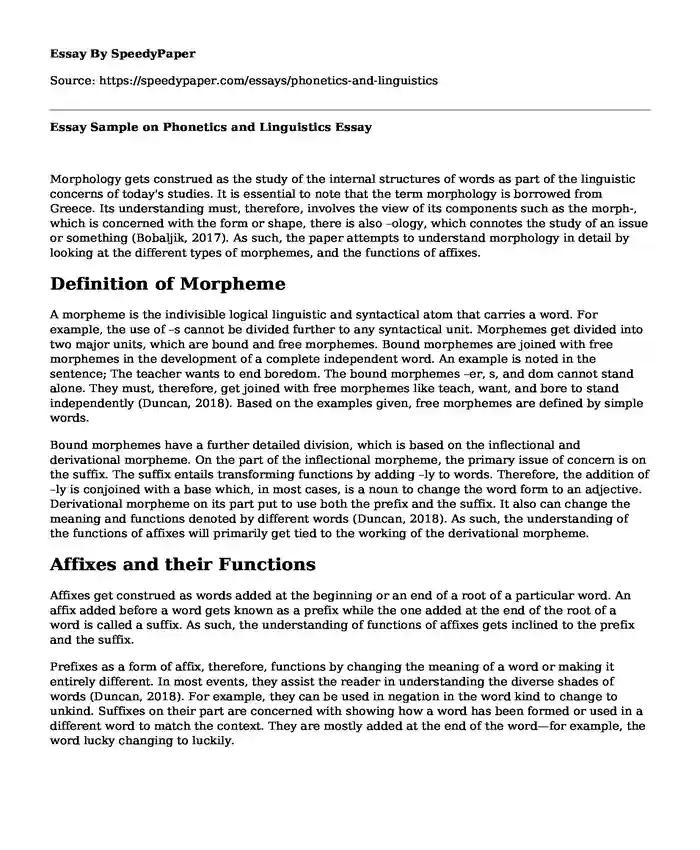
| Essay type: | Definition essays |
| Categories: | Knowledge Linguistics Languages |
| Pages: | 2 |
| Wordcount: | 515 words |
Morphology gets construed as the study of the internal structures of words as part of the linguistic concerns of today's studies. It is essential to note that the term morphology is borrowed from Greece. Its understanding must, therefore, involves the view of its components such as the morph-, which is concerned with the form or shape, there is also –ology, which connotes the study of an issue or something (Bobaljik, 2017). As such, the paper attempts to understand morphology in detail by looking at the different types of morphemes, and the functions of affixes.
Definition of Morpheme
A morpheme is the indivisible logical linguistic and syntactical atom that carries a word. For example, the use of –s cannot be divided further to any syntactical unit. Morphemes get divided into two major units, which are bound and free morphemes. Bound morphemes are joined with free morphemes in the development of a complete independent word. An example is noted in the sentence; The teacher wants to end boredom. The bound morphemes –er, s, and dom cannot stand alone. They must, therefore, get joined with free morphemes like teach, want, and bore to stand independently (Duncan, 2018). Based on the examples given, free morphemes are defined by simple words.
Bound morphemes have a further detailed division, which is based on the inflectional and derivational morpheme. On the part of the inflectional morpheme, the primary issue of concern is on the suffix. The suffix entails transforming functions by adding –ly to words. Therefore, the addition of –ly is conjoined with a base which, in most cases, is a noun to change the word form to an adjective. Derivational morpheme on its part put to use both the prefix and the suffix. It also can change the meaning and functions denoted by different words (Duncan, 2018). As such, the understanding of the functions of affixes will primarily get tied to the working of the derivational morpheme.
Affixes and their Functions
Affixes get construed as words added at the beginning or an end of a root of a particular word. An affix added before a word gets known as a prefix while the one added at the end of the root of a word is called a suffix. As such, the understanding of functions of affixes gets inclined to the prefix and the suffix.
Prefixes as a form of affix, therefore, functions by changing the meaning of a word or making it entirely different. In most events, they assist the reader in understanding the diverse shades of words (Duncan, 2018). For example, they can be used in negation in the word kind to change to unkind. Suffixes on their part are concerned with showing how a word has been formed or used in a different word to match the context. They are mostly added at the end of the word—for example, the word lucky changing to luckily.
References
Bobaljik, J. D. (2017). Distributed Morphology. In Oxford Research Encyclopedia of Linguistics.
https://www.laurakalin.com/s/DM_ORE.pdfDuncan, L. G. (2018). Language and Reading: the Role of Morpheme and Phoneme Awareness. Current developmental disorders reports, 5(4), 226-234.
https://link.springer.com/article/10.1007/s40474-018-0153-2
Cite this page
Essay Sample on Phonetics and Linguistics. (2023, Aug 09). Retrieved from https://speedypaper.com/essays/phonetics-and-linguistics
Request Removal
If you are the original author of this essay and no longer wish to have it published on the SpeedyPaper website, please click below to request its removal:
- Research Paper Sample - Teaching English Through Songs
- Letter of Purpose, Free Example
- Essay Example Describing Lewis and Clark Expedition
- Essay Sample on Chemo-enzymatic Biotransformation
- Paper Sample. Not Smart, Not Clever: Virtue Ethics
- Navigating Past Tenses: Teaching English Verbs to Asian Learners with Worksheets - Free Essay
- Report on Leadership Insights: Nehemiah's Strategy, Ezra's Teachings, and Personal Contribution Impact
Popular categories




